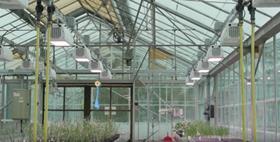
Scientists are “speed breeding” crops to help develop new varieties using NASA technology.
Researchers at the John Innes Centre, Earlham Institute, Quadram Institute in Norwich, and the University of Queensland, Australia, have adapted NASA’s technique for growing “extra-terrestrial” plants, to their own breeding programme.
By shortening breeding cycles, researchers can fast-track genetic improvements such as yield gain, disease resistance and climate resilience in a range of crops, such as wheat, barley and pea.
Speed breeding uses enhanced LED lighting of up 22 hours a day to optimise photosynthesis and promote rapid growth of crops. Being able to do this in a compact desktop chamber means they can be trialled before being scaled up to glasshouse size.
In the wake of the European Court of Justice’s ruling that effectively prohibits gene-editing as a method of breeding new varieties, speed breeding techniques could be the new breakthrough in cultivar development.
Dr Brande Wulff, a wheat scientist at the John Innes Centre and one of the lead authors on the paper says that European crop research and breeding will become more dependent on speed breeding in the light of these developments.
“Speed breeding allows researchers to rabidly mobilise the genetic variation found in wild relatives of crops and introduce it into elite varieties that can be grown by farmers. The EU ruling that heavily regulates gene editing means we are more reliant on speed breeding to grow sturdier, more resilient crops.”
Wulff’s team at the John Innes Centre has also developed techniques such as rapid gene discovery and cloning that in tandem with speed breeding, would allow crop improvements via a non-GM route.
“We know that more and more institutes across the world will be adopting this technology and by sharing these protocols we are providing a pathway for accelerating crop research,” Wulff said.



